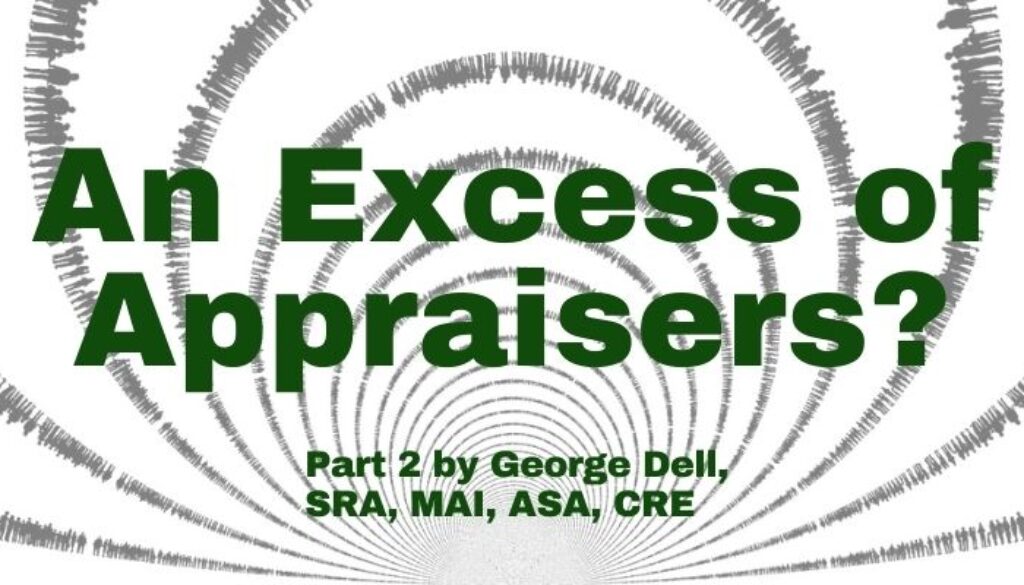How can we fix the excess of appraisers? Easy — we do what we have always done, each time . . .
1) We will raise the standards (“cost of entry”). 2) We will make it harder to become an appraiser; 3) Lower fees will discourage newcomer appraisers.
Each cycle, the ‘appraiser shortage’ cycles with an ‘excess’ of appraisers. Always just in time to exaggerate the economic cycle of real estate, rather than moderate it.

This is the way we’ve always done it.
In recent issues of the Analogue Blog, we have considered the “five forces of friction” on the advancement of valuation. Here we consider how these “frictions” will behave as appraisal demand drops. And just as each of the five forces find ways to reduce or “eliminate” the need for valuation expertise. Recall the five forces: practices, standards, education, regulation, and client expectation.
In this blog, we consider the first friction –valuation practice. How might practice be “modernized.” Revised to level the repeated ugly economic cycles, assist in diversity, eliminate bias, and wholly update the obsolescent, subjective, and un-reliable appraisal ‘process’.
“Established” appraisal practice: the first faltering friction.
- The traditional process is: 1) pick comps; 2) adjust comps; 3) form opinion; 4) deliver opinion.
- The modern science is: 1) isolate market; 2) measure market); 3) set subject; 4) deliver result.
Traditional point-value opinion provides no measure or even a sense of reliability or risk. The stated “trust me” goal is credibility – where the appraiser is just “worthy of belief” – as defined in USPAP.
For non-residential work, current practice is still dominated in the concepts of the accountant’s spreadsheet (with add-ons). The 40-year-old, hand-held HP12c remains the standard, even as modern real analytics software (and even the spreadsheet), are faster and transparent. Reconciliation, with no real reliability/risk assessment remain as narrative storyline about the ‘three approaches to value.’
For residential appraisal work, obsolete ‘form’ reports — box our logic. Focus on the ‘neighborhood’ obstructs the real objective – the market, analysis of the Competitive Market Segment, (CMS)©.
Reproducibility, connectivity, and actual reliability measures are foreign to traditional practice. This traditional ‘established’ appraisal practice remains the standard, the client expectation, the regulation enforcement, appraiser education and license certification pass scores.
Current data-stream technology makes obsolete those restrictions of old groupthink . . . Today’s modern methods of data science enhance and improve the core issues of public trust and equity.
Evidence Based Valuation (EBV)© will change things:
Economic cycles are moderated: 1) micro-forecasting of value; 2) risk/reliability scoring; 3) fundamental value measurement; 4) real-time revaluation; 5) policy (monetary and fiscal) refinement.
Bias – 1) Analytical bias is prevented through reproducible data models; and, 2) Personal bias (intentional and unintentional) is stopped by analyst similarity models, not the ‘trust me’ approach.
Diversity is enabled: 1) Prejudicial bias is minimized with evidence, not personal opinion judgment; and, 2) New technology-based methods are a natural for younger cohorts, and require minimal personal training, and no endorsement of “designation committees” necessary.
The excess of appraisers is temporary. Retirees will retire. Form-fillers will have no forms. The invisible hand of markets will promote public trust. Evidence based methods are here. Who will require them?

June 29, 2022 @ 6:13 am
Excellent!
June 29, 2022 @ 8:53 am
Yeah, and you got rid of this ‘excess’ appraiser by calling property appraisal an ‘industry’ instead of what it always has been and was intended to be, a profession. A profession demands complete and exclusive attention to the fulfillment of the demands and expectations due the professional. An industry only requires that the worker performs the assigned task. The Standards found in the Red Book as published by the Royal Institution of Chartered Surveyors demands complete professionalism and the member of the Royal Institution agrees to allow the Institution to bring the member “To Book” for violating the Standards of the Red Book. Not so with FNMA, who by way of the Dataset Forms that became obligatory in September 2011 has taken over the mortgage industry and the appraisal profession to bring both under its heel and make us pawns that serve its corporate structure by imposing its super-computer that is filled with the data we supplied it so that the human appraiser is no longer necessary but is now truly excess. Of course, California has to take things even further by politicizing appraisal by making ‘bias’ or prejudice punishable as a felony. I could not afford to renew my license in 2020 and given the way things are now, I would touch property appraisal with a ten-foot measuring tape as I could be sent to jail if the borrower didn’t agree with my value conclusion. You senior folk who were supposed to be the watchmen on the wall were derelict in your duties as all you could think of was yourselves. I tried, with ASA to bring FNMA to the realization of what their new form was doing to property appraisal. Instead of meeting with us, the senior executives sent their underlings instead, and the underlings rather rudely showed us the door. Where was the outcry from the Appraisal Institute over this treatment? The silence was deafening and told the rest of us that our days as appraisers and that of the profession were truly numbered. Enjoy the excess as you and the senior appraisers are most likely next in the replacement of humans by computing machines.